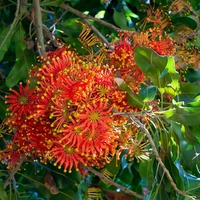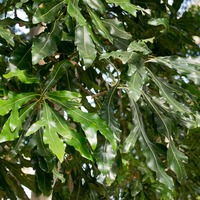Common name: Wheel of fire
Other common names: Firewheel tree, Tulip flower, White oak, White silky oak, Yiel yiel
Description
Wheel of fire is an ornamental and timber tree originating in Australia, where it occurs in subtropical forests on the continent's east coast.
It grows slowly, to heights of up to 30 m (98 ft) in its native habitat. However, it is usually 10 to 15 m (30 to 50 ft) tall and forms a straight, slender trunk 75 cm (2.5 ft) in diameter supporting a densely leafy columnar crown. The bark is dark grey to brown, sometimes wrinkled and with shallow fissures on older trees.
Leaves dark glossy green, up to 25 cm (10 in) long and deeply lobed on young trees, changing on mature trees to smaller elongated oval leaves with wavy margins.
The flowers are large, bright red and with an eye-catching spoke-wheel shape. They bloom from summer through autumn, in clusters borne directly on the trunk or mature branchwood, but are partially hidden by the dense foliage. Green, boat-shaped seed capsules follow, becoming black-brown when mature and then split open lengthwise to release their seed, which are winged for wind dispersal.
Use
Wheel of fire is cultivated in gardens, parks and urban landscapes for its shapely, compact form, lush green foliage and showy flowers.
The flowers also produce abundant nectar, helping to sustain nectar-feeding birds such as hummingbirds. Both the flowers and juvenile foliage is cut for use in floral arrangements.
The wood is medium-weight, averaging around 750 kgs per cubic meter (47 lbs per cubic ft) and has attractively figured reddish-brown heartwood. Large logs, when available, are sawn into lumber for making furniture and cabinets or are sliced for decorative veneer. Its natural durability against rot, decay and wood-boring insects is not well researched.
Climate
Grows naturally in moderately humid subtropical and tropical mid- to high-elevation climates, generally areas with annual lows of 10 to 20°C, annual highs of 19 to 30°C, annual rainfall of 700 to 2600 mm and a dry season of 6 months or less.
Growing
New plants are usually grown from seed or cuttings taken from semi-mature wood. Performs best on free-draining clay, loam and sand soils of an acid to neutral nature, generally with pH of 5.0 to 7.0, and on sites with full to partial sun exposure. It has poor tolerance to alkaline or limestone soils and soils high in phosphates.
Problem features
There does not appear to be any record of its escape and naturalisation anywhere, despite its widespread introduction and cultivation outside of its native range. It is assessed as a low weed risk species for Hawaii by the Hawaii Pacific Weed Risk Assessment (HPWRA) project.
Where it grows
References
Books
-
Barwick, M., et al. 2004, Tropical & subtropical trees : a worldwide encyclopaedic guide, Thames and Hudson, London
-
Editors of Sunset Magazine 2012, The New Western Garden Book: The Ultimate Gardening Guide, 9th edition, Sunset Publishing Corporation, California
-
Holliday, I. 2002, A field guide to Australian trees, 3rd revised editon, New Holland Publishers, Frenchs Forest, New South Wales
-
Lake, M. 2015, Australian rainforest woods : characteristics, uses and identification, CSIRO Publishing, Collingwood, Victoria
-
Macmillan, H. F. 1943, Tropical planting and gardening : with special reference to Ceylon, 5th ed, Macmillan Publishing, London
-
Menninger, E. A. 1962, Flowering trees of the world for tropics and warm climates, 1st ed., Heathside Press, New York
-
Oakman, H. 1995, Harry Oakman's what flowers when : the complete guide to flowering times in tropical and subtropical gardens, University of Queensland Press, St. Lucia, Queensland
-
Perry, B. 2010, Landscape plants for California gardens: an illustrated reference of plants for California landscapes, Land Design Publishing, Claremont, California
-
Staples, G. & Herbst, D. R. 2005, A tropical garden flora : plants cultivated in the Hawaiian Islands and other tropical places, Bishop Museum Press, Honolulu, Hawaii



